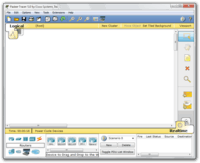Packet Tracer
|
| |
 Packet Tracer 5.0 in Windows 7 | |
| Developer(s) | Cisco Systems |
|---|---|
| Stable release |
7.2
|
| Operating system | Linux, Android 4.2+, iOS 8+ and Microsoft Windows |
| Platform | Windows, Linux, Android (operating system), iOS |
| Available in | English, Russian, German, Portuguese, Spanish and French |
| License | Proprietary |
| Website |
www |
Packet Tracer is a cross-platform visual simulation tool designed by Cisco Systems that allows users to create network topologies and imitate modern computer networks. The software allows users to simulate the configuration of Cisco routers and switches using a simulated command line interface. Packet Tracer makes use of a drag and drop user interface, allowing users to add and remove simulated network devices as they see fit. The software is mainly focused towards Certified Cisco Network Associate Academy students as an educational tool for helping them learn fundamental CCNA concepts. Previously students enrolled in a CCNA Academy program could freely download and use the tool free of charge for educational use.[1]
Overview
Packet Tracer can be run on Linux and Microsoft Windows. Similar Android[2] and iOS[3] apps are also available. Packet Tracer allows users to create simulated network topologies by dragging and dropping routers, switches and various other types of network devices. A physical connection between devices is represented by a "cable" item. Packet Tracer supports an array of simulated Application Layer protocols, as well as basic routing with RIP, OSPF, EIGRP, BGP, to the extents required by the current CCNA curriculum. As of version 5.3, Packet Tracer also supports the Border Gateway Protocol.[4]
In addition to simulating certain aspects of computer networks, Packet Tracer can also be used for collaboration. As of Packet Tracer 5.0, Packet Tracer supports a multi-user system that enables multiple users to connect multiple topologies together over a computer network.[5] Packet Tracer also allows instructors to create activities that students have to complete.[1] Packet Tracer is often used in educational settings as a learning aid.[6][7] Cisco Systems claims that Packet Tracer is useful for network experimentation.[8]
Role in Education
Packet Tracer allows students to design complex and large networks, which is often not feasible with physical hardware, due to costs.[6] Packet Tracer is commonly used by CCNA Academy students, since it is available to them for free.[1] However, due to functional limitations, it is intended by CISCO to be used only as a learning aid, not a replacement for Cisco routers and switches.[8] The application itself only has a small number of features found within the actual hardware running a current Cisco IOS version. Thus, Packet Tracer is unsuitable for modelling production networks. It has a limited command set, meaning it is not possible to practice all of the IOS commands that might be required.[9]Packet Tracer can be useful for understanding abstract networking concepts, such as the Enhanced Interior Gateway Routing Protocol by animating these elements in a visual form.[6][9] Packet Tracer is also useful in education by providing additional components, including an authoring system, network protocol simulation and improving knowledge an assessment system.[8]
See also
- Cisco Networking Academy
- GNS3
References
- 1 2 3 Sheikh Raashid Javid (May 2014). "Role of Packet Tracer in learning Computer Networks" (PDF). International Journal of Advanced Research in Computer and Communication Engineering. Retrieved 26 August 2018.
- ↑ Inc, Cisco Systems (2017-05-12), Cisco Packet Tracer Mobile, Cisco Systems, Inc., retrieved 2017-11-15
- ↑ "Cisco Packet Tracer Mobile on the App Store". App Store. Retrieved 2017-11-15.
- ↑ "Cisco Packet Tracer 5.3" (PDF). Archived from the original (PDF) on 2012-09-14. Retrieved 26 August 2018.
- ↑ Andrew Smith (31 August 2011). "Development of a Simulated Internet for Education". Research in Learning Technology. Archived from the original on 2017-08-16.
- 1 2 3 Dennis C. Frezzo; John T. Behrens; Robert J. Mislevy. "Simulation-Based Environment for a Community of Instructors: Design Patterns for Learning and Assessment" (PDF). Archived from the original (PDF) on 2017-08-16. Retrieved 26 August 2018.
- ↑ Yongbin Zhang. "Teaching Innovation in Computer Network Course for Undergraduate Students with Packet Tracer". Retrieved 26 August 2018.
- 1 2 3 "Cisco Packet Tracer" (PDF). Cisco Networking Academy. Retrieved 26 August 2018.
- 1 2 Jesús Expósito; Valentina Trujillo; Eric Gamess (20–22 October 2010). "Using Visual Educational Tools for the Teaching and Learning of EIGRP" (PDF). Proceedings of the World Congress on Engineering and Computer Science 2010 Vol I. Retrieved 27 August 2018.